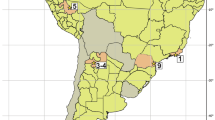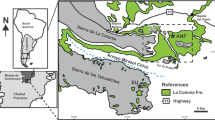Abstract
Fossil suid specimens recovered from the latest Miocene site of Shuitangba, Zhaotong Basin, Yunnan Province, provide new information on the classification and relationship of Chinese Miocene Suinae. Most of the recovered specimens are referred to a relatively advanced and large species of Suinae, Propotamochoerus hyotherioides, based on dental dimensions and morphology. Detailed morphological comparisons were made between the Shuitangba Pr. hyotherioides and other Asian Miocene suines. From these comparisons, we suggest that Pr. hyotherioides from Shuitangba and northern China may be relatively derived compared to the specimens from Lufeng and Yuanmou, southern China and that Pr. hyotherioides and Pr. wui represent separate branches of the genus in China. Furthermore, Microstonyx differs from Pr. hyotherioides in p4/P4 and m3/M3 characters. Molarochoerus is suggested to represent a relatively derived taxon due to the uniquely molarized upper and lower fourth premolars. Miochoerus youngi is suggested to have a closer relationship to Sus and Microstonyx than to Propotamochoerus due to its small size and p4 morphology. Hippopotamodon ultimus, Potamochoerus chinhsienense, Dicoryphochoerus medius, and D. binxianensis exhibit complex morphologies that variously resemble Propotamochoerus, Microstonyx, and Sus and are suggested to be possible transitional forms between Propotamochoerus, Microstonyx, and Sus. However, the resolution of their classification requires further analysis when more material is recovered.









Similar content being viewed by others
Change history
18 April 2018
The original version of this article unfortunately contained mistakes. Table 5 is the comparison of upper and lower molars. However, the published edition only showed the sub-title of the upper molars, and the sub-title of the lower molars are missing.
Abbreviations
- DAP:
-
Length of Premolar and Molar
- DLL:
-
Labio-Lingual Diameter
- DMD:
-
Mesio-Distal Diameter
- DT:
-
Maximum Width of a Cheek Tooth
- DTa:
-
Width of the First Lobe of a Cheek Tooth
- DTp:
-
Width of the Second Lobe of a Cheek Tooth
- DTpp:
-
Width of the Third Lobe of the Third Molar and the Deciduous Fourth Lower Premolar
- H:
-
Height
References
Boisserie J-R, Lihoreau F, Orliac M, Fisher RE, Weston EM, Ducrocq S (2010) Morphology and phylogenetic relationships of the earliest known hippopotamids (Cetartiodactyla, Hippopotamidae, Kenyapotaminae). Zool J Linn Soc 158:325–366
Chang YP (1974) Miocene suid from Kaiyuan, Yunnan and Linqu, Shanxi. Vertebr PalAsiat 12:117–125
Chen GF 1997 A new suid from the middle Miocene of Xinan, Henan. In: Tong YS, Zhang, YY, Wu WY, Li JL, Shi LQ (eds) Evidence for Evolution - Essays in Honor of Prof. Chungchien Young on the Hundredth Anniversary of his Birth. China Ocean Press, Beijing, pp 129–136
Colbert EH (1935) Distributional and phylogenetic studies on Indian fossil mammals. IV The phylogeny of the Indian Suidae and the origin of the Hippopotamidae. Am Mus Novitates 799:1–24
Coster P, Benammi M, Chaimanee Y, Yamee C, Chavasseau O, Emonet E-G, Jaeger J-J (2010) A complete magnetic-polarity stratigraphy of the Miocene continental deposits of Mae Moh Basin, northern Thailand, and a reassessment of the age of hominoid-bearing localities in northern Thailand. Geol Soc Am Bull 122:1180–1191
Dong W (1987) Miocene mammalian fauna of Xiaolongtan, Kaiyuan, Yunnan Province. Vertebr PalAsiat 25:116–123
Dong W, Zhang LM (2014) New materials of Hippopotamodon (Artiodactyla, Mammalia) from southern China. Vertebr PalAsiat 52:201–216
Fortelius M, van der Made J, Bernor RL (1996) Middle and late Miocene Suoidea of Central Europe and the eastern Mediterranean: evolution, biogeography and paleoecology. In: Bernor RL, Fahlbusch V, Mittmann H-W (eds) The Evolution of Western Eurasian Neogene Mammal Faunas. Columbia University Press, New York, pp 344–377
Han DF (1987) Artiodactyla fossils from Liucheng Gigantopithecus cave in Guangxi. Mem Inst Vertebr Paleontol Paleoanthropol Acad Sci 18:135–208
Hou SK, Deng T (2014) A new species of Chleuastochoerus (Artiodactyla: Suidae) from the Linxia Basin, Gansu Province, China. Zootaxa 3872:401–439
Jablonski NG, Su DF, Flynn LJ, Ji XP, Deng CL, Kelley J, Zhang YG, Yin JY, You YS, Yang X (2014) The site of Shuitangba (Yunnan, China) preserves a unique, terminal Miocene fauna. J Vertebr Paleontol 34:1251–1257
Ji XP, Jablonski NG, Su DF, Deng CL, Flynn LJ, You YS, Kelley J (2013) Juvenile hominoid cranium from the terminal Miocene of Yunnan, China. Chin Sci Bull 58: 3771–3779
Kaakinen A, Passey B, Zhang ZQ, Liu LP, Pesonen L, Fortelius M (2013) Stratigraphy and paleoecology of the classical dragon bone localities of Baode County, Shanxi Province. In: Wang XM, Flynn LJ, Fortelius M (eds) Fossil Mammals of Asia:Neogene Biostratigraphy and Chronology. Columbia Univeristy Press, New York, pp 203–217
Li YQ (1963) A new species of Potamochoerus from Chinhsien, Shansi. Vertebr PalAsiat 7:161–167
Liu JH, Ji XP (2004) Discovery of Propotamochoerus hysudricus from Tanguanyao area in Yongren, Yunnan Province, China. In: Dong W (ed) Proceedings of the Ninth Annual Meeting of the Chinese Society of Vertebrate Paleontology. China Ocean Press, Beijing, pp 49–54
Liu JH, Pan YR (2003) A new suid from the upper Miocene hominoid locality in Yuanmou of Yunnan Province. Yunnan Geology 22:176–191
Liu LP (2003) Chinese fossil Suoidea: systematics, evolution, and paleoecology. Helsinki University Printing House, Helsinki
Liu LP, Kostopoulos DS, Fortelius M (2004) Late Miocene Microstonyx remains (Suidae, Mammalia) from northern China. Geobios 37:49–64
Liu T-S, Li C-K, Zhai R-J (1978) Pliocene vertebrates of Lantian, Shensi. Prof Pap Stratigr Paleontol 7:149–200
Lydekker R (1877) Notices of new and rare mammals from the Siwaliks. Rec geol Surv India 10:76–83
Lydekker R (1884) Indian Tertiary and post-Tertiary Vertebrata. Siwalik and Narbada bunodont Suinae. Palaeontol Indica 3:35–104
Matthew WD (1929) Critical observations upon Siwalik mammals. Bull Am Mus Nat Hist 56:437–560
Pan YR, Liu JH, Dong W (2006) Artiodactyla. In: Qi GQ, Dong W (eds) Lufengpithecus hudieensis Site. Science Press, Beijing, pp 195–228
Pearson HS (1928) Chinese fossil Suidae. Palaeontol Sinica Ser C(5):1–75
Pickford M (1986) A revision of the Miocene Suidae and Tayassuidae (Artiodactyla, Mammallia) of Africa. Tert Res Spec pap 7:1–83
Pickford M (1988) Revision of the Miocene Suidae of the Indian subcontinent. Münchner Geowiss Abh A Geol Paläontol 12:1–91
Pickford M (1993) Old World suoid systematics, phylogeny, biogeography and biostratigraphy. Paleontol I Evol 26-27:237–269
Pickford M, Liu JH, Pan YR (2004a) Systematics and functional morphology of Molarochoerus yuanmouensis (Suidae, Mammalia) from the late Miocene of Yunnan, China. C R Palevol 3:691–704
Pickford M, Liu LP (2001) Revision of the Miocene Suidae of Xiaolongtan (Kayuan), China. Bull Soc Paleontol Italiana 40:275–283
Pickford M, Nakaya H, Kunimatsu Y, Saegusa H, Fukuchi A, Ratanasthien B (2004b) Age and taxonomic status of the Chiang Muan (Thailand) hominoids. C R Palevol 3, 65–75
Pilgrim GE (1926) The fossil Suidae of India. Paleontol Indica new ser 8:1–68
Schlosser M (1903) Die fossilen Säugethiere Chinas. Abh Konigl bayer Akad Wiss 22:92
Schmidt-Kittler N (1971) Die obermiozäne Fossillagerstätte Sandelzhausen 3. Suidae, Artiodactyla, Mammalia. Mitt Bayer Staatssamml Paläontol hist Geol 11:129–170
Sein C, van der Made J, Rössner GE (2009) New material of Propotamochoerus (Suidae, Mammalia) from the Irrawaddy Formation, Myanmar. Neues Jahrbuch Geol Paläontol-Abh 251:17–31
Tang YJ, Liu ZQ, Chen D, Chen LQ (1985) The fossil Suidae from late Miocene of Binxian, Shaanxi. Vertebr PalAsiat 23:60–68
Thenius E (1970) Zur Evolution und Verbreitungsgeschichte der Suidae. Z Säugetierk 35:321–342
van der Made J (1996) Listriodontinae (Suidae, Mammalia), their evolution, systematics and distribution in time and space. Contrib Tert Quatern Geol 33:3–254
van der Made J (2010) The pigs and “Old World peccaries” (Suidae and Palaeochoeridae, Suoidea, Artiodactyla) from the Miocene of Sandelzhausen (southern Germany): phylogeny and an updated classification of the Hyotheriinae and Palaeochoeridae. Paläontol Z 84:43–121
van der Made J, Han DF (1994) Suoidea from the upper Miocene hominoid locality of Lufeng, Yunnan Province, China. Proc Kon Ned Akad Wetensch, 97:27–82
van der Made J, Hussain ST (1989) “Microstonyx” major (Suidae, Artiodactyla) from Nagri. Estud Geol 45:409–416
Viret J (1961) Artiodactyla. In: Piveteau J (ed) Traité de paléontologie. Masson et Cie Éditeurs, Paris, pp 887–1084
Yue LP, Zhang YX (2006) Paleomagnetic dating of Lufengpithecus hudienensis localities. In: Qi GQ, Dong W (eds) Lufengpithecus hudienensis Site. Science Press, Beijing, pp 245–255
Zhang ZQ, Gentry AW, Kaakinen A, Liu LP, Lunka JP, Qiu ZD, Sen S, Scott RS, Werdelin L, Zheng SH, Fortelius M (2002) Land mammal faunal sequence of the late Miocene of China: new evidence from Lantian, Shaanxi Province. Vertebr PalAsiat 40:165–176
Acknowledgements
We thank all of those who participated in the fieldwork that resulted in the retrieval of these specimens. We would like to particularly acknowledge the assistance of the following individuals and institutions in providing field logistical support: Guodong Mao, Yuxi Museum, Institute of Vertebrate Paleontology and Paleoanthropology, Chinese Academy of Sciences, Yunnan Institute of Cultural Relics and Archaeology, Qujing Institute of Cultural Relics, Chuxiong Prefectural Museum, Zhaotong Government. Financial support is gratefully acknowledged from the National Science Foundation of the United States of America (BCS-1035897, BCS-1227964, BCS-1227927, BCS-1227838), the National Natural Science Foundation of China (41202002, 41430102), Yunnan Natural Science Foundation (Grant 2010CC010), Zhaotong Government, and Institute of Vertebrate Paleontology and Paleoanthropology, Chinese Academy of Sciences. S. Hou was funded by National Science Foundation of the United States of America BCS-1227964 (to D.F. Su) while undertaking this study. We are grateful to two anonymous reviewers and J.R. Wible for their insightful comments, which improved the quality and clarity of the manuscript.
Author information
Authors and Affiliations
Corresponding author
Additional information
The original version of this article was revised: Table 5 is the comparison of upper and lower molars. However, the published edition only showed the sub-title of the upper molars, and the sub-title of the lower molars are missing.
Rights and permissions
About this article
Cite this article
Hou, S., Su, D.F., Kelley, J. et al. New Fossil Suid Specimens from the Terminal Miocene Hominoid Locality of Shuitangba, Zhaotong, Yunnan Province, China. J Mammal Evol 26, 557–571 (2019). https://doi.org/10.1007/s10914-018-9431-3
Published:
Issue Date:
DOI: https://doi.org/10.1007/s10914-018-9431-3




